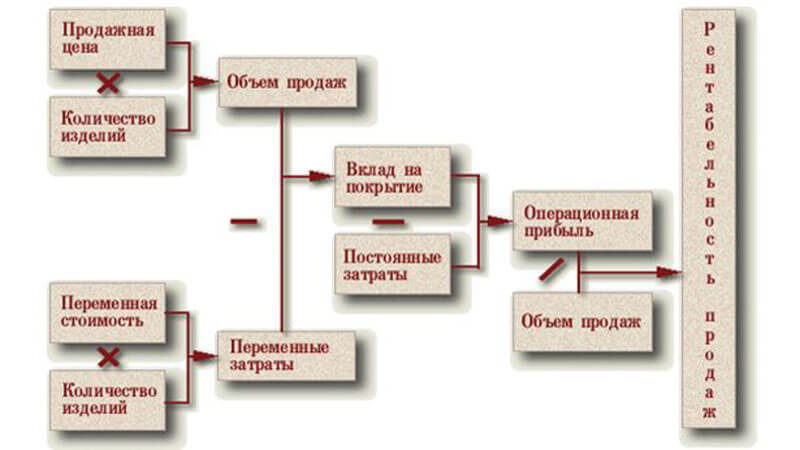How to calculate profitability? Formulas for analysis.
How to calculate profitability? Based on what financial statements? This article is devoted to the answers to these, as well as to many other questions regarding the calculation of the main financial indicators of an enterprise and their correct interpretation.
What is profitability?
Profitability ( from him. Rentabel - useful, profitable, profitable) is a set of relative performance indicators of the enterprise. The profitability of an enterprise reflects the level of efficiency in the use of resources at the disposal of the enterprise.
profitability ratio is one of the key financial analysis tools. This is a universal indicator that allows you to evaluate the efficiency of using various enterprise resources.
What is profitability in simple words? The calculation of profitability allows you to determine the share of profit ( gross or net) in the unit of the estimated resource.

How is profitability measured?
Profitability indicators can be presented in monetary terms. In this case, the coefficient will contain information about how much profit a resource unit generates. However, most often the profitability ratios are expressed as a percentage.
ROI video:
Types of profitability and how to calculate profitability
Enterprise profitability analysis is based on the calculation of a complex of coefficients.
The formulas for calculating all profitability ratios without exception include profit in monetary terms divided by the book value of the asset directly or indirectly participating in the generation of this profit.
The following are used in financial analysis:
- Return on sales ( Profit Margin),
- Profitability of fixed assets,
- Return on equity ( own and borrowed),
- return on investment,
- Staff profitability.
This is not a complete list of profitability indicators used in financial analysis. However, other indicators are, to one degree or another, derived from those listed.
Return on sales formula
Return on sales ( ROS) - return on sales (in many textbooks on financial analysis you can find the abbreviation PM ( Profit Margin)) is one of the most popular financial analysis ratios. It is calculated by the formula:
RM = Operating ( margin) profit/sales volume or
PM = line 050 of the balance sheet / line 010 of the income statement.
The popularity of this coefficient is explained, first of all, by the fact that it allows quickly assess performance enterprise management.
In fact, this indicator reflects the company's ability to generate profit through a competent pricing policy and effective management of operating costs. These “capabilities” are the key to the reliability of any enterprise.
It should be noted that the sales profitability ratio is not a “self-sufficient” evaluation criterion, however, like most other financial analysis ratios.
The share of profit in the trade turnover of the enterprise for a single period is not very informative. Its significant drawback is that its calculation does not take into account the volume of assets involved in generating profits and the period of their turnover.
Using this ratio to compare different enterprises ( even one area of activity) doesn't make much sense either.

Such a comparison may be of interest only to fans of statistics, because. Algorithms for the formation of cost at different enterprises can vary greatly. First of all, this applies to manufacturing enterprises.
By the way, the PM coefficient is most often used to analyze commercial enterprises and is extremely rare for enterprises in manufacturing and other areas that are characterized by high capital intensity.
It is advisable to use the profitability ratio of sales to evaluate the effectiveness of various projects within the framework of one diversified enterprise.
In this case, the evaluation criterion is the value of the indicator.
It can also be used to evaluate the effectiveness of managerial decisions - for this, they analyze the dynamics of changes in the indicator for a certain period ( usually several operating cycles of the enterprise).
The formula for the profitability of products sold ( return on sales) for a manufacturing enterprise can serve as a demonstration of a well-thought-out flexible pricing policy.
Quite often, in the numerator of the formula for calculating profitability, they use not operating profit, but net profit. This ratio is called “net return on sales”.
In our opinion, the profitability of sales in this edition even less informative. It is of little use for evaluating individual divisions of a diversified enterprise, primarily because the calculation of net profit takes into account the depreciation of general production and non-production fixed assets, and the criteria for distributing such costs between financial responsibility centers are always the “weak point” of any accounting system.
According to this indicator, different enterprises can be compared.

Production profitability formula
The production profitability ratio is calculated as the ratio of gross profit from the sale of finished products to the costs of its manufacture and sale.
Like Profit Margin, the production profitability indicator is an operational indicator; its use is advisable when conducting a comparative analysis of the effectiveness of the functioning of departments or projects of a diversified enterprise.
Also, this indicator is used to determine the profitability threshold - the minimum volume of finished products, the sale of which will generate an amount of profit sufficient to cover production and pre-sales costs.
The profitability threshold is also called the break-even point.
The formula for calculating the break-even point is as follows:
PR = PZ / KN, where
PR is the threshold of profitability, PZ is fixed costs, and KN is the coefficient of the trade margin (margin).
Profitability of fixed assets
The ability of an enterprise to generate profit is a very superficial characteristic of the effectiveness of its functioning.
The previously considered return on sales can serve as an evaluation criterion for the work of the trading department, it allows you to evaluate the ability of an enterprise to effectively manage highly liquid current assets ( goods and finished products) and control the level of operating costs.
The next step in assessing the financial condition of the enterprise and the efficiency of its functioning is the calculation of the profitability of its non-current assets, in particular, fixed assets.
This coefficient is calculated by the formula:
Profitability of fixed assets (ROFA) = Net income / total (book) value of fixed assets.
This indicator reflects the dynamics of the return of funds invested in non-current assets. In addition, the use of this ratio allows you to fairly objectively assess the effectiveness of the business model of the enterprise.
The degree of correlation of this indicator with various business processes allows you to identify those that require optimization. Based on this ratio, you can do the following:
- Conduct a comparative analysis of the effectiveness of various production sites;
- Assess the quality of work performance and the qualifications of working production sites;
- Evaluate the manufacturability of production.
The return on fixed assets is of interest not only to internal users. Along with the return on equity indicators, which will be discussed later, it is a convenient financial analysis tool used by potential investors and lenders.

Return on assets. Economic profitability
Economic profitability as a tool for financial analysis activity of the enterprise is one of the main objects of attention of the management of companies, since this aggregate and cumulative indicator demonstrates not only the dynamics of the movement of all types of financial and production assets of the enterprise.
It can be used to assess the structure of these assets, the level of production and other operating costs.
The coefficient is calculated by the formula:
Economic profitability ratio \u003d Profit before tax / Average asset value * 100.

Return on equity: balance sheet formula
Return on equity ratio ( ROE) reflects the ratio of net profit to equity capital of the enterprise ( 1st section of the liability balance).
In other words, this coefficient shows how much profit the owners of the enterprise received for each ruble invested.
The formula for calculating the coefficient:
ROE = net income / average equity.
In the process of evaluating the effectiveness of investments, this indicator is compared with alternative investment objects, incl. with the deposit rate of commercial banks.
This is the easiest way to calculate ROE. Its main disadvantage is that it does not take into account the structure of equity capital, more precisely, it does not allow determining what part of equity capital acts as a source of financing for current assets.
This shortcoming is deprived of Dupont's formula.
ROE = (Net Income/Revenue) * (Revenue/Assets) * (Assets/Equity)
The coefficient calculated by this formula is more informative. When calculating it, not only the return on assets is taken into account, but also the degree of financing of assets at the expense of equity capital.
Calculation of profit and profitability of sales, video:
Factor analysis of profitability
Factor analysis is one of the ways to comprehensively assess the financial condition of an enterprise based on the above coefficients. It is based on mathematical modeling.
Factor analysis involves the creation of mathematical relationships ( dependencies) between the studied indicators. Such multifactorial models can be of the following types:
- Additive ( the resulting factors are added or subtracted),
- Multiplicative ( factors multiply),
- Multiples. division of factors.
A wide selection of modeling algorithms allows you to reproduce real business processes in mathematical formulas with high accuracy.
Internal rate of return
Internal Rate of Return ( IRR) is used to determine the economic efficiency of investment projects.
It is expressed as a percentage and shows such a rate at which the incoming ( positive) the cash flow during the implementation of the investment project will be equal to the outgoing ( negative) cash flow.

When calculating the internal rate of return, high accuracy is very important, because. the slightest mistakes made at this stage promise big troubles for the project developers in the future.
As a rule, IRR is calculated by iterative selection of interest rate values when calculating the NPV of the project. To facilitate the work of designers, powerful software systems have been created today that are able to calculate all the necessary indicators in a short time.




